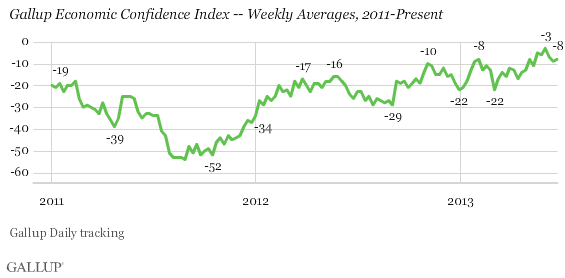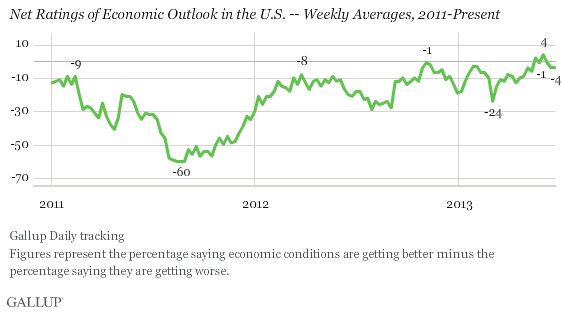PRINCETON, NJ -- Americans' confidence in the economy is holding steady, with the public a bit more negative than positive about U.S. economic conditions. Gallup's Economic Confidence Index for the week of June 17-23 was -8, virtually unchanged from the last two weeks, but down slightly from a peak of -3 in late May and early June. Confidence remains on the higher end of what Gallup has measured the last five years.

The emerging stability in economic confidence is also apparent from the June to-date average of -8, which, if it holds, would essentially match the May monthly score of -7. The May reading is the best monthly score in Gallup's five-year history of tracking economic confidence daily. Although confidence peaked near the end of May, it was lower earlier in the month. Thus, the overall May and June figures are similar even though there has been a modest decline in confidence during June.
Gallup's Economic Confidence Index summarizes two questions -- Americans' ratings of current economic conditions in the United States and their assessments of whether the economy is getting better or worse. Positive index scores suggest Americans are more positive than negative about the economy, and negative scores indicate Americans are more negative than positive. The index has been in negative territory since Gallup began tracking economic confidence daily in January 2008.
For the most recent week, 21% of Americans rate U.S. economic conditions as "excellent" or "good," while 33% say they are poor. That results in a -12 score for current conditions, in line with what Gallup has measured this month, but continuing a trend of more positive ratings of the economy this year than in 2011 and 2012.

Forty-six percent of Americans say the economy is getting better and 50% worse, for an economic outlook score of -4. That is the third consecutive week of slightly more negative than positive evaluations of the economy's direction, after the measure twice broke into positive territory in recent weeks.

Implications
Americans' optimism about the economy was growing at the beginning of June, and it seemed the public was poised to become more positive than negative about the U.S. economy. After a slight dip in Americans' economic confidence, that momentum has stalled, and confidence has appeared to stabilize. More volatile stock prices, a still-worrisome employment picture, and tepid economic growth are all possible contributors to the stall in confidence.
However, confidence remains above where it has been in recent months and years, and in some respects, including stock values and the housing market, the economy is much stronger today than it was during the recession and its immediate aftermath.
Gallup.com reports results from these indexes in daily, weekly, and monthly averages and in Gallup.com stories. Complete trend data are always available to view and export in the following charts:
Daily: Employment, Economic Confidence, Job Creation, Consumer Spending
Weekly: Employment, Economic Confidence, Job Creation, Consumer Spending
Read more about Gallup's economic measures.
View our economic release schedule.
Survey Methods
Results for this Gallup poll are based on telephone interviews conducted June 17-23, 2013, on the Gallup Daily tracking survey, with a random sample of 3,560 adults, aged 18 and older, living in all 50 U.S. states and the District of Columbia.
For results based on the total sample of national adults, one can say with 95% confidence that the margin of sampling error is ±2 percentage points.
Interviews are conducted with respondents on landline telephones and cellular phones, with interviews conducted in Spanish for respondents who are primarily Spanish-speaking. Each sample of national adults includes a minimum quota of 50% cellphone respondents and 50% landline respondents, with additional minimum quotas by region. Landline telephone numbers are chosen at random among listed telephone numbers. Cellphone numbers are selected using random digit dial methods. Landline respondents are chosen at random within each household on the basis of which member had the most recent birthday.
Samples are weighted to correct for unequal selection probability, nonresponse, and double coverage of landline and cell users in the two sampling frames. They are also weighted to match the national demographics of gender, age, race, Hispanic ethnicity, education, region, population density, and phone status (cellphone only/landline only/both, cellphone mostly, and having an unlisted landline number). Demographic weighting targets are based on the March 2012 Current Population Survey figures for the aged 18 and older U.S. population. Phone status targets are based on the July-December 2011 National Health Interview Survey. Population density targets are based on the 2010 census. All reported margins of sampling error include the computed design effects for weighting.
In addition to sampling error, question wording and practical difficulties in conducting surveys can introduce error or bias into the findings of public opinion polls.
For more details on Gallup's polling methodology, visit www.gallup.com.
